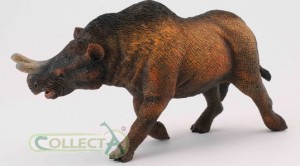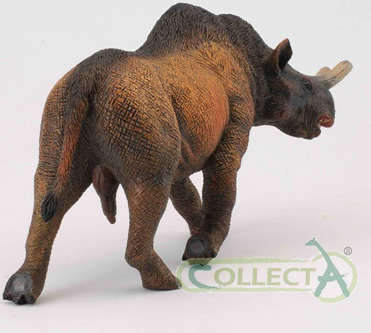A Review of the CollectA Megacerops (Thunder Beast Reviewed)
One of the more unusual additions to the CollectA range of prehistoric animal models was the introduction in 2012 of the model of the “Thunder Beast” known as Megacerops (M. coloradensis). Figures of prehistoric mammals only make up a small proportion of most figure and model manufacturer’s model ranges. Dinosaur models are far more common. The addition of this extinct, hoofed giant which resembled a rhinoceros, but was actually more closely related to a zebra was most welcome.
The CollectA Megacerops Model
Picture credit: Everything Dinosaur
CollectA Megacerops Prehistoric Mammal
Megacerops was a member of a group of extinct mammals known as brontotheres (the name means “thunder beasts”). They first evolved during the Eocene Epoch and were mainly forest dwelling herbivores. The largest of which was about the size of an Alsation dog, although most species of these perissodactyl mammals (odd number of toes on each foot), were no bigger than a Coyote. As the world became drier and extensive grasslands began to form on the landmasses that made up the continents of the Northern Hemisphere, so these creatures diversified and radiated. They spread throughout Asia and North America.
Megacerops was one of the last of the brontotheres to evolve. Fossils of this creature have been found in the western United States. The fossils are so abundant that most of the regional museums in the area have Megacerops fossils within their natural history collections.
Model Measurements
The CollectA Megacerops model measures a fraction under twenty centimetres in length. It is a male, and if this hand painted replica does indeed represent M. coloradensis, then an approximate scale for this model can be calculated. If the length of large males are estimated to be around 4.5 metres, then a twenty centimetre model would represent a 1:22.5 scale figure.
The painting is excellent on this particular prehistoric animal model, the texture of the coat can be easily seen. The designers have opted to give their model a darker head with the rear of the animal painted a lighter tan colour. The ears are facing forward and the animal is depicted as if it were charging, perhaps chasing off some predatory hyaenodonts. Even the tail with its little tuft of hair at the end has been very finely modelled. The two “V-shaped” horns that are positioned just above the nostrils have been painted a light grey colour.
Brontotheres
The horns of brontotheres were very probably covered with skin when the animal was alive. The model has a prominent hump between the shoulders. Fossils suggest that many species of brontotheres did indeed have such a hump, it was probably a store of fat to help the animals survive leaner times.
The Award Winning CollectA Megacerops Model
Picture credit: Everything Dinosaur
CollectA Megacerops
It is a very beautiful model, such a treat to have a relatively little-known brontothere added to a mainstream model maker’s range, However, a warning to mums and dads, this model is anatomically accurate. The CollectA Megacerops was awarded the accolade of the best, new prehistoric animal model of 2012 as voted for by readers of a popular model collectors magazine. This Megacerops has redefined the standard of prehistoric mammal models and set the benchmark very high for other manufacturers. A very desirable and collectible prehistoric animal model.
To view Everything Dinosaur’s range of prehistoric animal models in the CollectA Deluxe/Supreme replica series: CollectA Deluxe Prehistoric Life Models and Figures.




I love how Collect had the stones to depict their models as real animals, and embracing the fact that 50% of titanotheres had penises!